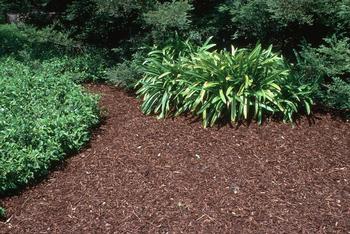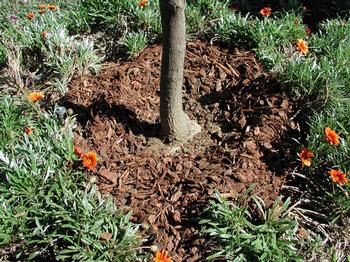Got mulch? Add it to your garden for many benefits
-
Julie McMillan
-
Adding the right amount and type of mulch will help your garden thrive, especially during drought and hot weather, and it’s one of the easiest and least expensive things you can do. The best time to add mulch is early spring to early summer, but it is also beneficial to add it any time during the growing season. When you’re considering mulch, you will want to follow fire-smart landscaping recommendations
 A layer of organic mulch protects the soil and enhances the garden. Photo: Jack Kelly Clark, courtesy of University of California Statewide IPM Progra
A layer of organic mulch protects the soil and enhances the garden. Photo: Jack Kelly Clark, courtesy of University of California Statewide IPM PrograMulch is defined as any material used to cover the soil surface. Mulch mimics the natural environment found in forests where leaves and other natural materials blanket the soil surface. As they decompose, these materials replenish nutrients and create an ideal environment for root growth.
A thin layer of mulch will provide many benefits in your own garden. Mulch will lower the water requirements of plants by slowing evaporation; moderate soil temperature; limit weeds by reducing he light they need to grow; control soil erosion and dust; improve soil structure, fertility and aeration; prevent soil compaction; and visually enhance your landscape.
There are three types of mulch material to consider:
- Organic mulches are derived from materials that were once alive, so can improve soil conditions as they decompose. They are often inexpensive, sometimes even free. Organic mulches include wood chips, straw, alfalfa hay/pellets, manure, grass clippings, tree leaves, and compost. However, all organic mulches are combustible and should not be placed near your home, discussed below.
- Inorganic mulches such as rocks or gravel are naturally occurring, but not from living sources. They do not decompose to improve the soil, and usually must be purchased. However, in very hot areas, rocks and gravel can radiate heat and cause extreme temperatures around plants, resulting in water loss causing severe plant stress. Inorganic mulch material should be placed in the immediate perimeter around your home, discussed below.
- Synthetic mulches are manufactured, and although they may decompose, they will not improve soil organic material. These must be purchased. Rubber is an example of a synthetic mulch.
Before applying mulch, smooth out the soil, remove weeds and install irrigation equipment (drip irrigation is more efficient than sprinklers). Then apply the mulch, but not too much: A layer 1½”-3” deep is plenty. Thicker than this will restrict air and water movement, and can result in “mulch toxicity,” creating anaerobic (without air) conditions. This could lead to leaves yellowing, scorching or dropping, and even plant death Mulch properly placed around a tree trunk. Photo: Cheryl A. Reynolds, courtesy of University of California Statewide IPM Program
Mulch properly placed around a tree trunk. Photo: Cheryl A. Reynolds, courtesy of University of California Statewide IPM ProgramKeep mulch 4”-6” inches away from the stems of plants and tree trunks. Wet mulch piled against the base of plants can cause them to rot. In addition, about 70% of North American native bees are solitary ground-nesters. If you have a well-drained, sunny spot (preferably on a slope), don’t cover it with mulch to allow a habitat for native bees.
When you use mulch, it is critical to follow fire-smart landscaping recommendations.
To protect your home, create defensible space in the first 5’ around your home, also known as “Zone Zero.” During a wildfire, embers can accumulate in Zone Zero, providing an ignition source for combustible materials and then adjacent structures. Since all organic mulch treatments are combustible, do not add organic mulch within the first 5’ of your house or other structures. In Zone Zero, use non-combustible rock, gravel, or pavers instead.
Beyond Zone Zero, you can use organic mulch, but be aware that some types are less flammable than others. A 2008 study recommended composted wood chips because they had the slowest fire spread. Avoid shredded western red cedar bark, or “gorilla hair,” because they ignite most easily, and spread fire most rapidly. Pine needles (and shredded rubber) also have more hazardous fire behavior.
For more information about mulch, please visit http://marinmg.ucanr.edu/BASICS/MULCH/Applying_Mulch/
For more information about FireSmart Landscaping, please visit http://marinmg.ucanr.edu/BASICS/FIRESMARTLANDSCAPING/


